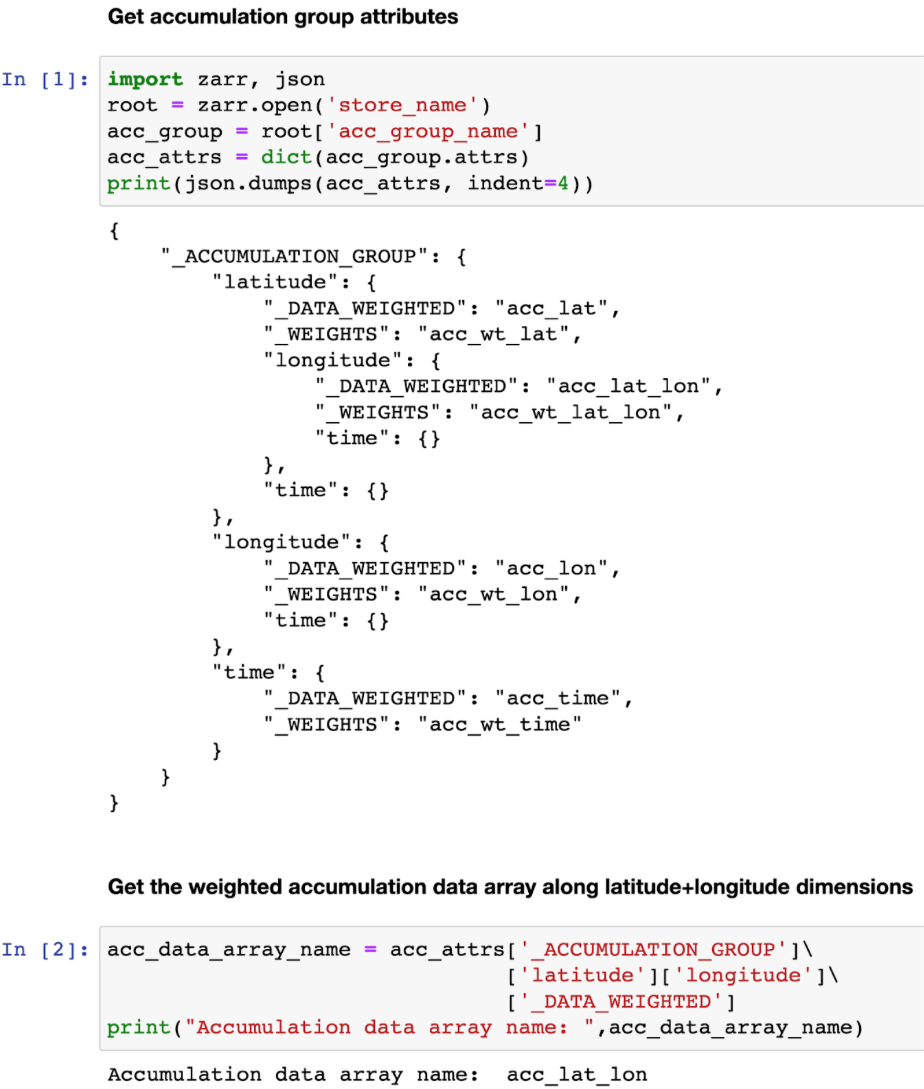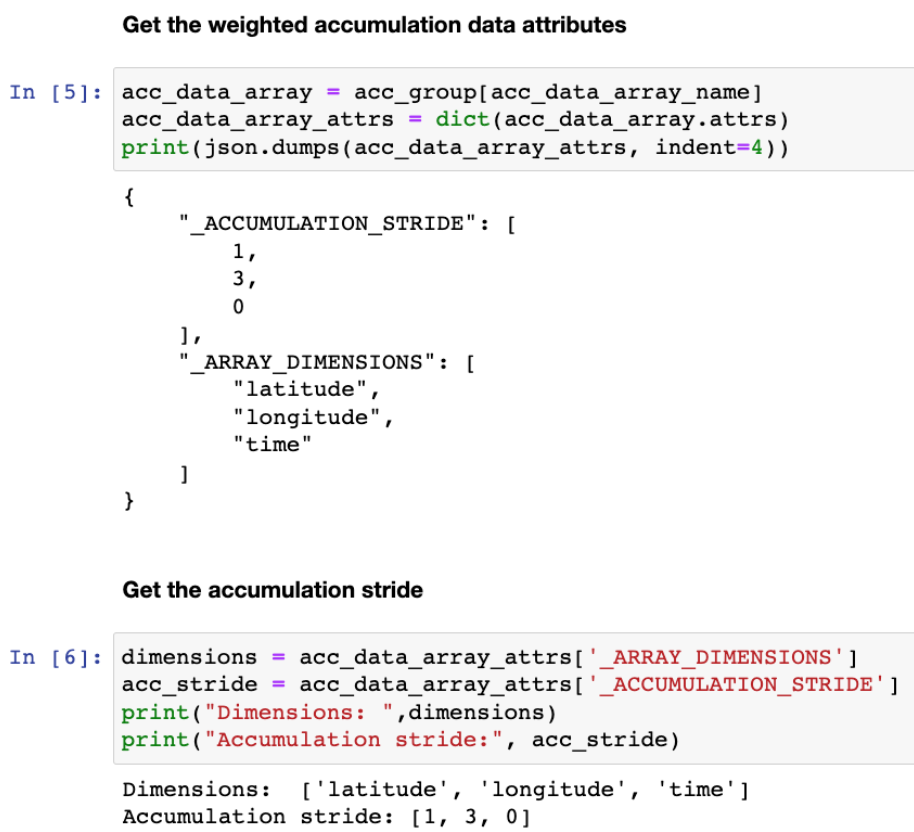ZEP 5 — Zarr-based Chunk-level Accumulation in Reduced Dimensions
Authors:
- Hailiang Zhang (@hailiangzhang), Adnet Systems Inc, NASA Goddard Space Flight Center.
- Mahabal Hegde (@nasahegde), NASA Goddard Space Flight Center.
- Christine Smit (@christine-e-smit), Telophase Co, NASA Goddard Space Flight Center.
- Brianna Pagan (@briannapagan), Adnet Systems Inc, NASA Goddard Space Flight Center.
- Dieu My Nguyen (@dieumynguyen), Adnet Systems Inc, NASA Goddard Space Flight Center.
Status: Draft
Type: Specification
Created: 2023-02-12
Discussion: https://github.com/zarr-developers/zarr-specs/pull/205
Abstract
At NASA GES DISC, we receive a large number of user requests each day for a variety of analysis and visualization services involving averaging along one or more dimensions, some of which are computationally expensive when running against large amounts of geospatial data. We proposed a generic and dimension-agnostic method based on chunk-level cumulative sums (accumulation) on a regular grid, which provides fast and cost-efficient cloud analysis for multidimensional averaging services. This method introduces a small adjustable set of auxiliary data on top of the raw data, and dramatically reduces the computational time by orders of magnitude based on chunk-level accumulation along one or more dimensions.
We hereby propose a Zarr extension for this chunk-level accumulation approach. In this proposal, we will present a Zarr group for the accumulation data, a JSON schema for the accumulation group attribute, a JSON schema for the accumulation data array attribute, and an example of the user application interface.
Motivation and Scope
At NASA GES DISC, our use case is for computing averages along a range of data dimensions (e.g., space, time) in a cost effective and highly performant manner. In the Geo-spatial community, computing area or temporal averages over a long range of observations is popular with users. Performing the averaging operation over data in Zarr generally requires a full scan of the data. This can be parallelized with Dask (or any other distributed framework), but reading all of the data is an unavoidable bottleneck. Our proposed approach, Zarr-based Chunk-level Accumulation, will improve the speed and cost of long-range calculation by loading only a few data chunks at the averaging boundary. Here, we provide examples of how the approach is applied to geospatial data with temporal and spatial dimensions; however, it’s noteworthy that this approach is dimension-agnostic and can be generalized for all types of multidimensional data aggregation services with Zarr.
Detailed description
The fundamental of this Zarr-based Chunk-level Accumulation algorithm is to pre-compute cumulative sums of data values and weights/counts along data dimensions at the chunk intervals. These cumulative sums can then be used to find data averages for dimension ranges.
Example:
For a sequence A=(a, b, c, d), the cumulative sums are S=(s0, s1, s2, s3) where s0=a, s1=a+b, s2=a+b+c, s3=a+b+c+d. The average of the sequence over a range can now be calculated using the cumulative sums. For example, assuming zero-based indexing, average (A[1:])=(S[3]-S[0])/3=(s3-s0)/3.
The above example can be extended and generalized for multiple dimensions. This makes the problem of computing averages O(1) vs O(N^m) for the dimensions being averaged, where N is the number of data values and m is the number of dimensions to be averaged. See our ESIP 2022 presentation (and the slides) for a more detailed description.
Implementation
We propose to formalize this Zarr-based Chunk-level Accumulation approach as a Zarr extension. To implement this approach, cumulative sums are computed at chunk intervals and are stored in a Zarr group. The API for averaging the data fetches the necessary pre-computed sums based on the user-requested dimensions (e.g., time) and dimension ranges (e.g., from 1980 to 1990).
Please note that this solution is also applicable for storing chunk statistics (min, max, sum, count, etc.) to help with performing aggregations.
Zarr group structure of accumulation data
Rather than storing the chunk-level statistics in a separate store, we could store them inline with the arrays they are derived from. This would enable other applications to take advantage of such pre-computed data to optimize queries. This is similar to an optimization in Snowflake (twitter link).
The accumulation datasets are organized in a data group adjacent to the raw data and dimension arrays with the following structure:
├── ${dimension_array}
├── ...
├── ${raw_dataset}
├── ...
└── ${raw_dataset}_accumulation_group
├── .zgroup
├── .zattr
├── ${accumulation_dataset_1}
│ ├── .zarray
│ ├── .zattr
│ └── ...
├── ${accumulation_dataset_2}
│ ├── .zarray
│ ├── .zattr
│ └── ...
...
where ${dimension_array} is the data array for the dimension variable, ${raw_dataset} is the data array for the raw dataset, ${raw_dataset}_accumulation_group is the group for accumulation, and ${accumulation_dataset_1} and ${accumulation_dataset_2} are the data arrays for each accumulation dataset.
Zarr attribute file of accumulation group
The accumulation group attribute file, ${raw_dataset}_accumulation_group/.zattr, provides details of the accumulation implementation and data organization. It follows the JSON schema shown below:
{
"$schema": "http://json-schema.org/draft-07/schema#",
"type": "object",
"definitions": {
"accumulation_data_array": {
"type": "object",
"properties": {
"_DATA_UNWEIGHTED": {
"type": "string"
},
"_DATA_WEIGHTED": {
"type": "string"
},
"_WEIGHTS": {
"type": "string"
}
},
"patternProperties": {
"^(?!_DATA_UNWEIGHTED|_DATA_WEIGHTED|_WEIGHTS).*$": {
"$ref": "#/definitions/accumulation_data_array"
}
},
"additionalProperties": false
}
},
"properties": {
"_ACCUMULATION_GROUP": {
"type": "object",
"patternProperties": {
"^(?!_DATA_UNWEIGHTED|_DATA_WEIGHTED|_WEIGHTS).*$": {
"$ref": "#/definitions/accumulation_data_array"
}
},
"additionalProperties": false
}
},
"required": [
"_ACCUMULATION_GROUP"
]
}
The recursive definition (#/definitions/accumulation_data_array) under the schema root (_ACCUMULATION_GROUP) provides details of the cumulative sum statistics, including the dataset names, accumulation types and dimensions. The keys of its properties (_DATA_UNWEIGHTED, _DATA_WEIGHTED, and _WEIGHTS) indicate the cumulative sum types (for unweighted data, weighted data, and weights respectively), whereas its values give the cumulative sum dataset names. The accumulation dimension names are saved in the keys of its patternProperties along the recursion chain; it is noteworthy that these dimension names need to be ordered to avoid ambiguity and redundancy.
An example of the above zarr attribute file is given as follows. The data has three dimensions including latitude, longitude and time. The cumulative sums are computed for the weighted data (_DATA_WEIGHTED) and weights (_WEIGHTS). If we want to provide the time-averaged map and area-averaged time series, the accumulation is only needed for the dimension combinations of latitude, longitude, time, and latitude+longitude; all other dimension combinations (e.g. latitude+time, longitude+time, and latitude+longitude+time) are empty ({}).
{
"_ACCUMULATION_GROUP": {
"latitude": {
"_DATA_WEIGHTED": "acc_lat",
"_WEIGHTS": "acc_wt_lat",
"longitude": {
"_DATA_WEIGHTED": "acc_lat_lon",
"_WEIGHTS": "acc_wt_lat_lon",
"time": {}
},
"time": {}
},
"longitude": {
"_DATA_WEIGHTED": "acc_lon",
"_WEIGHTS": "acc_wt_lon",
"time": {}
},
"time": {
"_DATA_WEIGHTED": "acc_time",
"_WEIGHTS": "acc_wt_time"
}
}
}
Zarr attribute file of accumulation data array
With Zarr-based chunk-level accumulation, the cumulative sums are not necessarily computed for every single chunk. To further reduce the computation and storage cost for the accumulation data, the cumulative sums can be computed every certain number of chunks, and we call this tunable number the accumulation stride. This information is saved in the Zarr attribute file for the accumulation dataset (e.g., ${raw_dataset}_accumulation_group/{accumulation_dataset_1}/.zattr).
As mentioned above, the dimension labels are needed to identify the accumulation datasets. We assume that the dimensions are defined in the attributes of the dataset as _ARRAY_DIMENSIONS as from the xarray implementation. In the present approach, the accumulation stride is saved in an object called _ACCUMULATION_STRIDE in parallel with _ARRAY_DIMENSIONS. The related schema segment of this attribute file is shown as follows:
{
"$schema":"http://json-schema.org/draft-07/schema#",
"type":"object",
"properties":{
"_ARRAY_DIMENSIONS":{
"type":"array",
"items":{
"type":"string"
}
},
"_ACCUMULATION_STRIDE":{
"type":"array",
"items":{
"type":"integer"
}
}
},
"required":[
"_ARRAY_DIMENSIONS",
"_ACCUMULATION_STRIDE"
]
}
The _ARRAY_DIMENSIONS and _ACCUMULATION_STRIDE arrays should have the same length. Each item in the _ACCUMULATION_STRIDE array represents the accumulation stride along the dimension from the _ARRAY_DIMENSIONS array at the same index. The value of accumulation stride should be a non-negative integer: a positive value represents the accumulation stride as defined above, whereas a value of 0 indicates the accumulation is not performed along the given dimension.
For example, the following attribute file represents the accumulation that is performed along only the time dimension every other chunk:
{
"_ARRAY_DIMENSIONS":[
"latitude",
"longitude",
"time"
],
"_ACCUMULATION_STRIDE":[
0,
0,
2
]
}
and the following attribute file represents the accumulation that is performed along the latitude dimension for each chunk, and along longitude dimension every 3 chunks:
{
"_ARRAY_DIMENSIONS":[
"latitude",
"longitude",
"time"
],
"_ACCUMULATION_STRIDE":[
1,
3,
0
]
}
Application Interface
The accumulation-based workflow requires the application to locate the accumulation data along certain dimensions. The accumulation data array name for the given dimensions can be obtained from the accumulation group attributes. The following example shows the steps to get the weighted accumulation data array name along latitude+longitude dimensions:

The accumulation stride is also needed to locate the accumulation data for a given chunk number. They can be obtained from the accumulation data attributes, and the following example shows the steps to get the accumulation stride for the accumulation data along latitude+longitude dimensions:

References and Footnotes
- ESIP Summer 2022 Presentation on Zarr-based chunk-level cumulative sums in reduced dimensions for fast high-resolution data analysis:
- Xarray Zarr Encoding Specification
- Snowflake table statistics
Copyright
This proposal is licensed under the Apache License, Version 2.0.